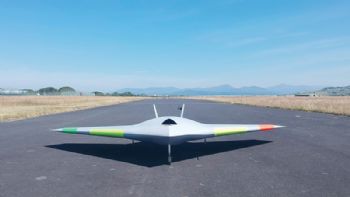
In a series of ‘ground-breaking’ flight trials that took place recently in the skies above north-west Wales, the MAGMA unmanned aerial vehicle (UAV) demonstrated two innovative flow control technologies that could revolutionise future aircraft design.
The aircraft, which was developed by researchers at the University of Manchester in collaboration with engineers from BAE Systems, successfully trialled two ‘flap-free’ technologies designed to improve the control and performance of aircraft by replacing moving surfaces with a simpler ‘blown air’ solution, thereby paving the way for engineers to create better-performing aircraft that are also lighter, more reliable and cheaper to operate.
The new technologies could also improve an aircraft’s stealth, as they reduce the number of gaps and edges that currently make aircraft ‘more observable’ on radar.
Julia Sutcliffe, chief technologist at BAE Systems Air (
www.baesystems.com), said: “MAGMA is a great example of how collaborating with bright minds at British universities can deliver ground-breaking research and innovation.
"Our partnership with the University of Manchester has identified cutting-edge technology — in this case, flap-free flight — and turned what began as a feasibility study into a proven capability in just a few months. It demonstrates how STEM can be applied in the real world.”
Bill Crowther, senior academic and leader of the MAGMA project at the University of Manchester, said: “We are excited to be part of a long-standing effort to change the way in which aircraft can be controlled, going all the way back to the invention of wing warping by the Wright brothers.
“We made our first fluidic thrust vectoring nozzle from glued-together bits of plastic and tested it on a hair drier fan nearly 20 years ago.
"Today, BAE Systems is 3-D printing our components out of titanium, and we are flight-testing them on an aircraft designed and built by the project team. It doesn’t get much better than that.”
The technologies demonstrated in the trials were: Wing Circulation Control (taking air from the aircraft’s jet engine and blowing it supersonically through narrow slots around a specially shaped wing trailing edge in order to control the aircraft); and Fluidic Thrust Vectoring (controlling the aircraft by blowing air jets inside the nozzle to deflect the exhaust jet and generate a control force).